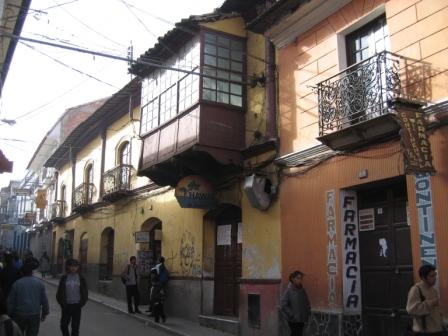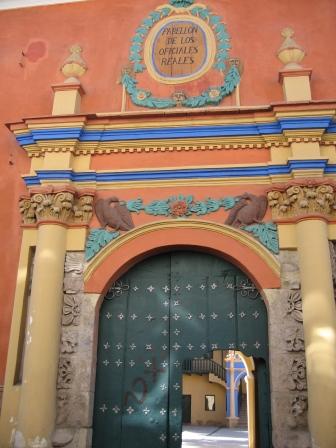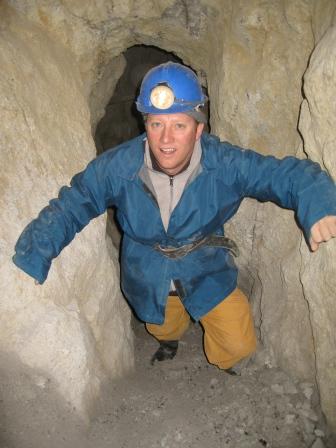Marc & Nora ROUND THE WORLD 2005/2006 - Join us!
BOLIVIA: Potosi
Together with Tara and Alistair we arrived in Potosi after spending 1 night in a freezing hotel room in Uyuni.
Potosi is actually the highest city of its size in the entire world. It was founded by the Spaniards in 1545 after they had discovered the mine workings at Cerro Rico mountain.
By the early 17th century Potosi used to be the richest and largest city in South America due to the immense aount of silver that extracted here.
In the spanish language there is a saying: "Es un Potosi" which is used when describing anything supremely rich.
However, over the next few centuries silver was also found elsewhere and the amounts of silver found in Potosi decreased. From being once the richest town in the Americas Potosi developed into a ghost town.
Potosi today is a beautiful little town, large parts are colonial - with many gazebos and oriels and impressive doorways. UNESCO has declared Potosi to be a World Cultural Heritage Site. There are in fact more than 2000 (!!) colonial buildings in Potosi.
Very impressive is the Casa Nacional de Moneda (the colonial mint) in which even money for Spain was printed.
We walked up a small tower in the city centre (my god how exhausting again to walk up a few steps) from which we had a great 360ºC panoramic view over the city.

Potosi Town Centre

Potosi

Potosi

The entrance of Casa Moneda

La Casa Moneda

Potosi

Potosi and Cerro Rico
Potosi today lives from tourists visiting the infamous mine at Cerro Rico - the mines are still active working mines and the conditions under which the people have to work can hardly be described in words - you really have to experience it yourself!
The state mines were closed in the 1980s but the mines still operate as so-called "cooperatives" by small group of miners. The miners are in fact completely exploited as they have to pay for their tools such as dynamite.
Now the most devastating fact:
More than 9 Million (!!!) miners died within 200 years of mining in Cerro Rico. The conditions under which the miners had (and still have) to work were/are horrible: In colonial times miners stayed underground for 6 months!
In this period they did not get to see the sunlight once - therefore many turned blind once being outside again!
the dust and poison in the mines resulted in many other fatal sicknesses - not to mention accidents due to poor structure!
Tara, Alistair, Marc and I decided NOT to go on a full day tour as we thought that 2,5 hours below ground would be enough! How right we were!
First stop was a garage where we got changed. Overalls, pants, helmet, lighs and wellington boots was our mining outfit!

4 miners ready to explore the mine
Next stop was the miners market. Here we could purchase gifts for miners - things like coca leaves for chewing (not only for the altitude but chewing coca leaves also results in less appetite - hence takes your hunger and also keeps you awake - hence increased working), soft drinks, beer, strong stuff (95% alcohol made from sugar canes), cigarettes and...
...most important: DYNAMITE!!!
we heard about it but it is a different thing to see nytroglycerin live and to touch and actually buy it and have it in the bus with us...how bizarre and how scary!
with a lot of gifts we made our way to the mine.
Before entering the mine we could see how dynamite was blown up outside.
This was too much for me...I didnt want to watch! The explosion was loud enough for me - even 100 meters away!
We then entered the mine - the entrance was full of Llama blood - a tradition that happens once a month. A llama is sacrificied and the blood is distributed around the entrance wall. The blood of the llama should "feed" the god of the miners so that he doesnt kill any miners.
To enter the mines you should be physically fit (no asthma) and not suffer from claustrophobia.
Great! being diagnosed in Buenos Aires with Asthma and using an Asthma inhalor since every morning I was really worried.
We descended a few levels and constantly had to squeeze onto the wall as "helpers" (men with wheelbarrows) rushed by. It was really dusty and much of the wall was covered with some poisonous cristals which we shouldnt touch.
Our guide distributed our gifts to miners and we even watched how one guy prepared dynamite for some explosions.
The guide screamed all of a sudden: "run run! the dynamite will explode in 1 minute" and we all ran - not knowing where to and falling over rocks and holes!
it wasnt funny at all - the guide (a woman) thought she was very funny to scare us but in our opinion it was unprofessional and stupid!
we also got to see a museum in the mine - in fact it is a place where all miners go on a Friday when they finish for the weekend.
In colonial times the Spaniards invented a kind of god that looks like a devil and put images of this devil in the mines. The Spaniards told the miners that this god (DIO) is watching them so they work harder. The miners had (and still have) great respect of this god and offered him gifts (cigarettes, alcohol) so he would be gentle and friendly to them and would take care of their well-being. Now this devil is more like a friend and instead of DIO (spanish for god) they call him TIO (spanish for Uncle and mate).

Parts of the mine

Marc the miner

TIO - the former Devil, now God of the Miners. Here they come and drink on Fridays and leave gifts for Tio.
We saw 15 year old boys that just started a 36hour shift pushing wheelbarrows with 60 kg of stones.
We also saw some other young guys pulling buckets up by a rope which weighed 50kg each. marc had a go - it was really exhausting - imagine doing that 14 hours without break and under such conditions (no light, bad air, dust, 36ºC)
It is really sad to see under what conditions those guys have to work. Their daily "salary" is 50 bolivianos max (a bit more than 3 pounds - 4,5 euros) - and they have to buy dynamite and other tools on their own expenses...crazy!
We then descended further and further - there were no steps, just gravel and rocks and steep descents where we literally slipped down and it got tougher and tougher to breathe and to walk - most of the times we had to walk ducked and at the very end we literally crawled through the tunnel on our hands and knees - the height of the tunnel was maybe 1 meter and the width was the same. Everywhere are holes so you really have to watch out your steps.
all together it was an interesting but saddening experience to witness first hand a working mine, whose operations consist mainly of manpower, for there are few machines doing the dirty work. The floors are slippery, the walls muddy and the air 40m underground (4th level) is extremely bad - not to mention the temperature which is extremely high due to the narrow tunnels (up till 40ºC).
During our visit we could hear popping noises - explosions that take place on different levels.
We almost finished our tour when we were stood close to 2 miners who were waiting for a bucket filled with 200kg of stones to be let down from a higher level.
All of a sudden there was this horrendous noise, almost like an explosion and the air filled with dust.
we were all terrified. I screamed to the guide if that is normal and what happened and she just replied it was an accident.
The 200kg bucket has fallen down a few meters - right next to the miners. luckily they were ok. we could not see anything due to the dust and we could hardly breathe so we quickly crawled back the tunnel to get some "fresh" air.
it was awful! our lungs were full of dust!
after a few minutes the dust disappeared and we started to ascend. The last tunnel was so narrow that we were literally crawling on our knees - the light at the end of the tunnel was such a relief - i cant describe it in words.
Outside we caughed and spat the dust out and during the bus journey home we didnt speak much - the shock of what we have seen was too big!
this was a life-time experience - i personally wouldnt do it again but i dont regret doing it!
it was also probably the most unnecessary life risk we have ever taken...

preparing an explosion - on the right you can see 3 dynamite sticks and on teh left next to the guy you can see the fuse.

in a very low and narrow tunnel
We were just about to finish our tour when we saw HIM in the mine as well - BILL CLINTON!
he was friendly enough to pose for a photo - thank you Bill!

Bill

Believe it or not - but we had MEAT FONDUE in a really nice restaurant in Potosi - dead cheap and soooo good!
(Alistair, Tara and I)
| Start of journey: | Sep 12, 2005 |
| Duration: | 11 months |
| End of journey: | Jul 31, 2006 |
United Kingdom
Thailand
Malaysia
Cambodia
Singapore
Australia
Australia & Pacific
New Zealand
South America
Chile
Argentina
Bolivia
Peru
Ecuador
Canada
